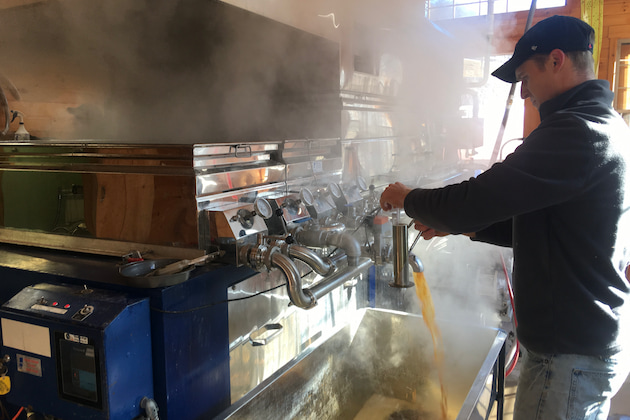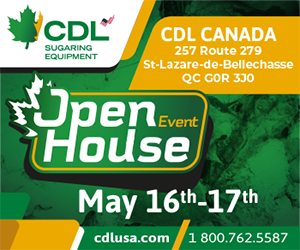Headlines
Sugarmakers urged to pay attention to quality
Stay away from off-flavored syrup
By LES OBER, GEAUGA COUNTY OSU EXTENSION | OCTOBER 5, 2022
BURTON, Ohio—Maple grading and maple quality have become major topics at just about every maple syrup meeting.
Why has this topic taken on a new sense of importance? What is driving this interest?
As the popularity of maple syrup products continues to grow, we are introducing more new customers to pure maple syrup.
As interest grows, so does the number of questions about content, grading and nutritional value.
Consumers ask! What is the difference between pure maple syrup and table syrup? Is this a superior product to table syrup and is it worth the price they are paying for it?
In most stores you find maple syrup right above the pancake flour.
The shelf space is minimal and is often shared with Log Cabin, Mrs. Butterworths, and other corn syrup derivatives.
The first thing consumers notice is that is substantially more expensive.
They also take time to read the label and make a direct comparison.
The lower priced competition has a multitude of ingredients.
Many have names they cannot pronounce, and probably do not want to consume.
So, they gravitate to the pure maple syrup which contains only one ingredient, Pure Maple Syrup. Many assume because they are paying a premium price it has to be a premium product.
Consumers today have established an association between price and quality and for the most part they do not mind paying a premium price for something they truly enjoy.
The key statement here is “You only have one opportunity to make a first impression."
There is variability in the maple syrup that is sold across the country. There are USDA Standards for color and density.
Density is straight forward, at least 66.0 or 66.9 depending on where you live.
When it comes to color grade standards and what they mean?
This can be confusing, there is a definite learning curve for first time buyers, with very little in store information to help them.
To add even more mud to the water, many states do not require grading, it is voluntary.
Remember, much of the syrup marketed in the US, especially outside the maple producing regions, is sold in box stores.
Most of the time the syrup sold through the discount chains is good syrup.
It is sweet and it has a maple flavor but every now and then a bottle of syrup, with an uncharacteristic flavor appears on the shelf. It is often marketed under a generic label.
Many would compare buying this brand of syrup, to buying a box of “Cracker Jacks”, you are wondering what sort of prize will be inside.
This is one of the reasons why buying from local producers is encouraged.
The flavor of our maple products is possibly the single most important aspect of maple grading. Flavor more than anything else sell the product. It is also one of the least understood aspects of grading.
There is a lot of variation in flavor for multiple reasons.
Some would say it is subjective, but it is not.
In reality, each grade has its own identifiable unique flavor characteristics.
Because blending to get color is discouraged but not restricted, what happens to flavor when you combine two grades of pure maple syrup to achieve a more exact color?
It is common knowledge that you can blend color, but you cannot blend flavor.
If it is graded the result is a batch of syrup that meets color standards, but the flavor, is just off.
The average consumer may not detect the difference.
After all, the only thing most consumers have as a comparison, is table syrup.
However, what happens when an off flavor is blended into the syrup?
Unfortunately, off flavored syrup can often be traced back to mistakes made by the producer.
Think about it, for every effect there has to be a cause, anyone who has ever run an evaporator realizes that.
Ten minutes to long on the evaporator, poor sanitation or running too late in the season, can all result in off flavors and sub-standard syrup.
Mistakes happen, and in most cases, they are not intentional.
To salvage the syrup, these mistakes often end up in a barrel, that is sold into the bulk market for whatever the producer can get.
This is what everyone does because flavor is subjective, right?
For sure, there is a limited market for substandard syrup.
However, unless this syrup is ear marked for a specific use, it should never be allowed to enter the market.
Overall, the industry as a whole does a good job of grading density and color and is beginning to put more emphasis on flavor quality.
However, it is the responsibility of everyone involved to know when something has gone wrong. Because we are selling a food product, we need to know where to draw the line.
Trust me, if producers who are intentionally trying to sell an off-flavor syrup, end up dumping a few barrels of rejected syrup, they soon will realize that producing and attempting to market sub-standard syrup has no return.
Remember I am not directing these comments at producers who are currently making and selling some of the finest maple syrup in North America.
Rather it is to encourage producers, that want to learn more about the process of making quality maple syrup, to attend a local or regional maple grading/quality workshops.
Raising the quality bar cannot be done through state regulations.
It can only be achieved through mutual cooperation and education at all levels of the industry.
































